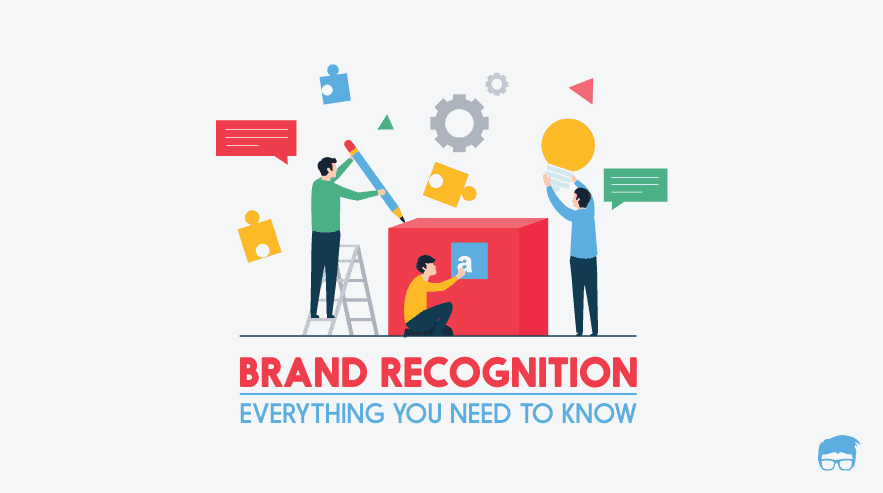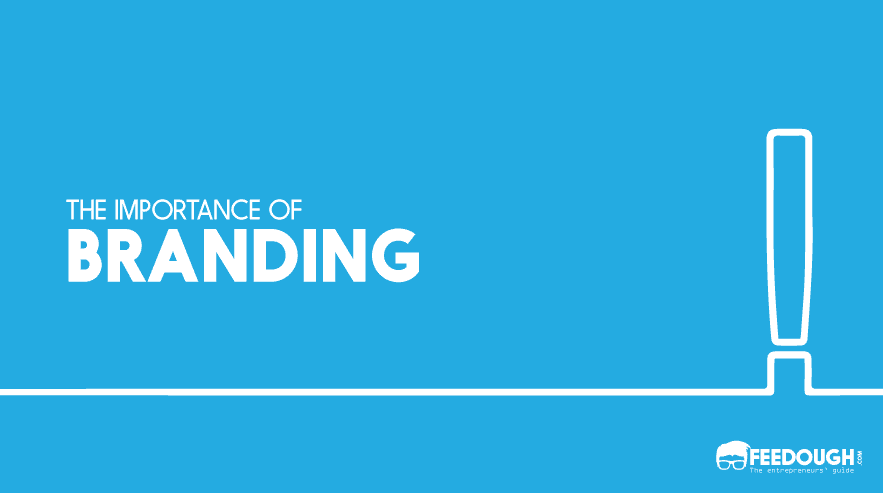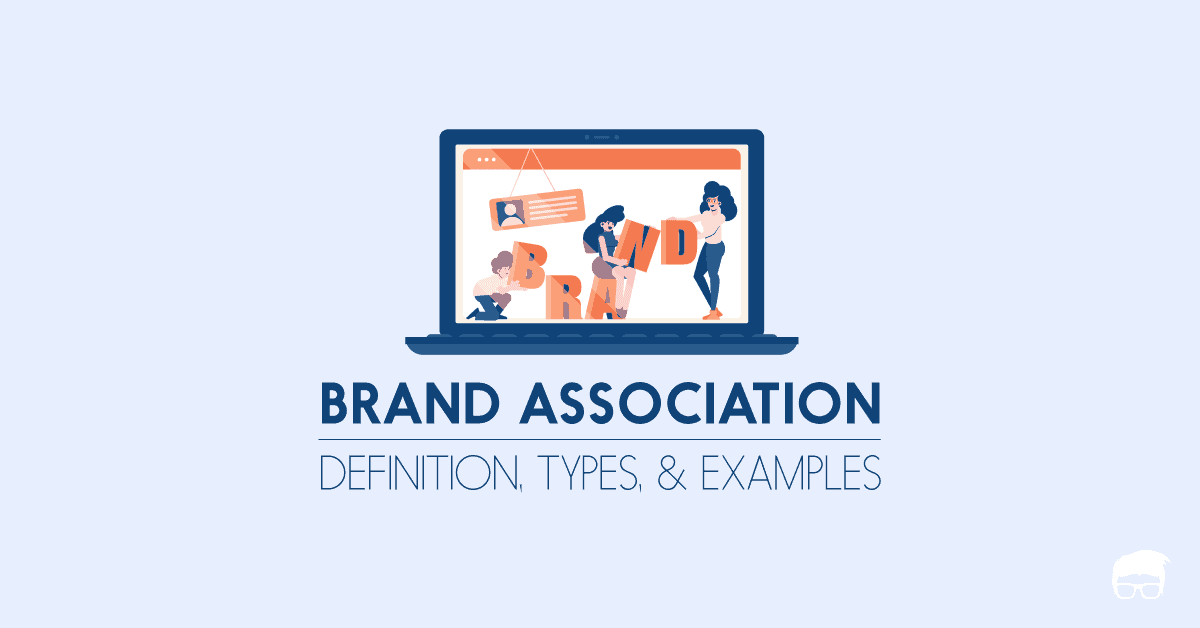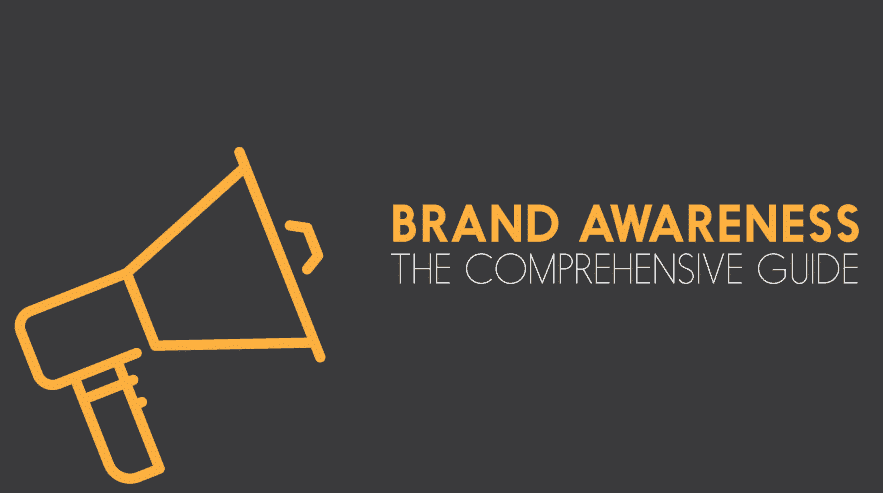A brand is the company’s most valuable asset. It is what the customer recognises, remembers, and often buys when he thinks of the product category.
One of the key aspects of measuring a brand’s success is its recognition by the target audience. Companies spend millions to achieve it and yet it can often take years to build.
This article takes a closer look at brand recognition, its importance and how companies work to build it.
What Is Brand Recognition?
Brand recognition is when the customer can recognise the brand and differentiate it from other brands when he comes into contact with it.
In simple terms, brand recognition is the ability of a customer to recognise a brand from its distinctive logo, tagline or an audio cue. It is a type of brand awareness which doesn’t require the customer to recall the name. It just focuses on whether the customer can recognise it when it is presented at the point-of-sale or when he witnesses the visual packaging.
It is often called aided recognition through visual recognition when viewing an ad, seeing its logo or auditory recognition when listening to a jingle associated with that company.
Importance Of Brand Recognition
Once the audience understands what the company offers and the company has gained enough traction and popularity, people begin to recognise it. People can recognise the company regardless of being customers or not. For example, most of the people can recognise an Audi on the road just by the car’s design or the company’s logo. Even if they don’t recognise the brand name, they recognise that it’s a premium automobile brand.
Gives Competitive Edge To The Company
Customers today are relatively more knowledgeable than before and therefore, any brand needs to truly stand out in order to gain their trust. This is where brand recognition comes into play. For instance, when posed with two identical products offered by different companies the consumer will choose the company he/she already recognises.
Thus, it ensures that customers lean towards that brand while making a decision, giving the company a competitive edge over others.
Improves Marketability Of The Product
An increase in marketability means a known and recognised brand is more appealing to buyers. Customers are often willing to pay a premium price for a product sold by a recognised company and choose it over its generic equivalents.
Enhances Brand Equity
The more people recognise a brand, the more valuable it becomes. Brand equity is the value of the brand as a separate asset.
High brand recognition helps in building the perceived value of the brand.
How To Build Brand Recognition?
Building brand recognition is an ongoing process. The goal of this process is to make the brand memorable and more appealing to the audience. And this is done by understanding the buyer’s journey and the stages of recognition of a brand.
The Five Levels Of Brand Recognition
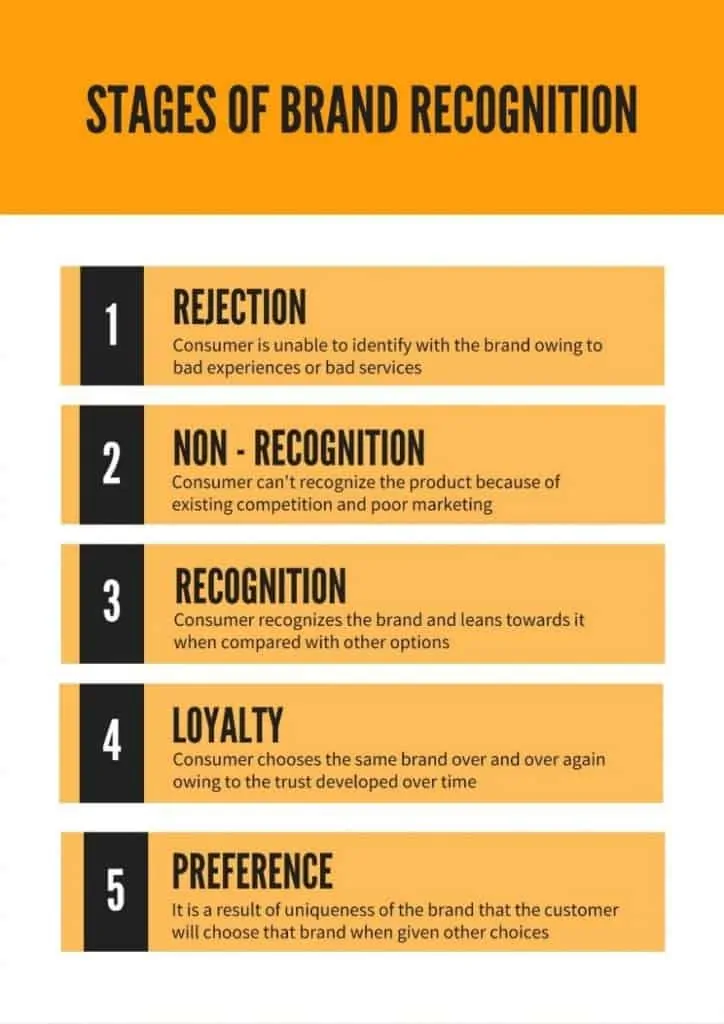
- Brand Rejection: If a customer associates the brand to something negative, they tend to avoid that brand.
- Brand Non-Recognition: This occurs when the consumer is unable to distinguish the company’s product from its competitors due to an unrecognised logo or name and poor marketing strategies.
- Brand Recognition: Consumer recognises the brand upon viewing its logo, tagline or with an audio cue.
- Brand Loyalty: Customer chooses the same brand repeatedly owing to the trust developed over time.
- Brand Preference: Preference means the customer will lean towards the recognised brand when offered other choices.
Strategies To Build Brand Recognition
Understand Target Audience Better
It is important to understand the target audience’s demographics and psychographics profile to gain insight into what is most relevant for them. There are various online tools that can be used for this purpose like Google Analytics and Facebook Insights. They provide a variety of information ranging from age and location to their behaviours and interests.
Build Memorable Brand Associations
The visual aspects of any brand such as the logo and tagline form the image of the brand. It should be designed in a way that is strong, distinctive yet balanced. It should be easy to grasp and communicate the business. Logos should be on the face of everything. Companies should keep reinforcing its name and its logo everywhere possible so it’s easier to grasp and persists in the customer’s mind.
Following are some examples of the most famous brand logos, most of which can be recognised without the brand’s name.
Some of the most recognizable taglines –
- “Just Do It” – Nike
- “Open Happiness” – Coca Cola
- “I’m lovin’ it” – McDonald’s
- “Melts in Your Mouth, Not in Your Hands” – M&M
- “Think Different” – Apple
- “Inspire the Next” – Hitachi
- “Das Auto” – Volkswagen
Make Use Of Influencer Marketing
Social media is undoubtedly one of the best platforms to reach out to customers. Social media influencers are instrumental in further increasing this reach. It becomes easier to target the right audience using short videos and relevant hashtags shared by the influencers. It is one of the subtle methods of online marketing which is almost certain to generate a decent amount of clicks and conversions. Influencers tend to have a well-established audience that trusts them. Thus, if the influencer shares the products with the audience, they would naturally gravitate towards it.

For example, ‘mostlysane’, an Indian YouTuber with more than 1.9 million Instagram followers, is now the face of H&M India’s store. She also tied up with Yatra.com and appears in commercials for Whatsapp.
Develop A Unique Product Packaging
Unboxing is a part of the product journey. Allowing consumers to customise their packaging can make the purchase a lot more exciting. Moreover, including the logo, name, and tagline of the brand in the packaging improves retention. Even the smallest of initiatives like including a bookmark when a customer purchases a book can have a huge positive impact. Personalised packaging seems like a gift for the customers.
A unique product packaging increases brand recognition.
Ask For Customer Feedback
Any customer’s opinion about a product they’ve used is important to better serve their needs and helps in identifying areas of improvement. Customers always appreciate when asked for product reviews as it makes them feel like their opinions are valued.
Brands that recognise the value of human interactions succeed in enhancing their recognition in the market.
Make Commercials Worth Remembering
A company’s commercial should be a reflection of the company’s values and identity. An ad should make people go, “This is what I was looking for”, or “This ad is for me”. This is achieved when the right audience is targeted such that they relate with the product or services offered. Even advertisements that can inspire a dialogue leaves an impact on the minds of the customers.
Marketing experts estimate that an American sees 4,000 to 10,000 ads every day. Any advertisers’ job is to cut through that noise and make the ad stand out.
For example, Apple’s 1984 commercial for Macintosh computers revolved around the concept of a futuristic society, drawing inspiration from George Orwell’s book, 1984. This ad was a huge success and purchases worth $155 million were made after its debut.
Brand Recognition and Brand Recall
Brand recognition and brand recall both fall under the umbrella of brand awareness.
Brand recall is sometimes referred to as unaided or spontaneous recall while brand recognition is referred to as aided recall. Moreover, brand recognition is not about the customer remembering the brand name rather about the customer recognising the brand when presented at the point of sale. Whereas, brand recall refers to how well a customer can recall the brand from their memory when prompted by a product category.
Go On, Tell Us What You Think!
Did we miss something? Come on! Tell us what you think of our article on brand recognition in the comments section.
An entrepreneur with a background in management, looking for opportunities to learn and grow every day.
